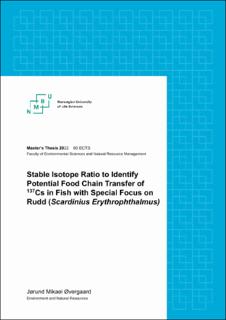| dc.contributor.advisor | Teien, Hans-Christian | |
| dc.contributor.advisor | Kasparov, Valery | |
| dc.contributor.advisor | Oughton, Deborah Helen | |
| dc.contributor.author | Øvergaard, Jørund Mikael | |
| dc.date.accessioned | 2022-10-20T07:56:30Z | |
| dc.date.available | 2022-10-20T07:56:30Z | |
| dc.date.issued | 2022 | |
| dc.identifier.uri | https://hdl.handle.net/11250/3027214 | |
| dc.description.abstract | The uptake of radionuclides such as radiocaesium (137Cs) in fish occurs mainly through diet. Generally, it is assumed that the transfer of 137Cs in predatory fish is higher than in non-predatory fish. In the present work food chain transfer of 137Cs in fish was studied in the Lake Glubokoye in Chernobyl Exclusion Zone (ChEZ) by analysis stable carbon (δ 13C), stable nitrogen (δ 15N) and 137Cs in fish, bentic organisms, water plants and insects collected in and at shore of the contaminated lake.
Results show that the assumed non-predatory fish rudd (Scardinius Erythrophthalmus) had average of 10.74 kBq kg−1 of 137Cs, at least similar activity concentration of 137Cs as in species of fish more associated with predatory behavior such as pike and perch. Roach was measured to a overall lower activity concentration of 137Cs with average measured of 2.79 kBq kg−1 while pike, perch and rudd have all individuals with over 10.0 kBq kg−1 activity concentrations.
The activity concentration of 137Cs in organisms at Lake Glubokoye was highly variable. Five plants collected in October 2021 was in range from 0.83 to 48.9 Bq g−1 dry weight. In the Benthic predator (Odonata) 137Cs was measured to 8.42 Bq g−1 . Snails collected showed a 137Cs level of 20.89 Bq g−1 in the body, and 1.66 Bq g−1 in the shell. Several of the terrestrial insects had to low biomass possible to detect 137Cs. Samples possible to detect had activity concentration of 137Cs up to 7.49 Bq g−1 . The millipedes(Diplopoda) had an 137Cs of 22.10 Bq g−1 . 137Cs was detected in all groups of feed organisms studied, except in the low biomass samples.
The δ 13C in rudd had an average of 28.93 ± 1.24 ‰ and was found to be significantly higher than for other fish species. It is a clear difference in δ 13C signature of aquatic insects that had an average of 34.56‰ and terrestrial insects with an average of 26.43‰ being more similar to rudd. Results suggest that 137Cs could be transferred from feeding of terrestrial-insects by rudd, as this seems to be a significant part of the diet to rudd. This is supported by the fact that analysis of intestine content contains different fractions of exoskeleton from invertebrates.
The activity concentration of 137Cs was significantly higher in rudd collected during June in 2017, with an average of 19.77 kBq kg−1 137Cs, than the rudd collected during autumn in 2021. While the δ 13C was found to be significantly lower in June of 2017, with an average of (-30.01‰), compared to autumn 2021. This indicate a move towards an aquatic food source as a source for explaining high 137Cs. The δ 15N was found to be significantly higher in June 2017 with a average of 7.12‰ compared to October 2021 ( 6.26 ‰ ), still significantly lower than for the predatory fish, but a move towards an isotope signature less different to the predatory fish could be observed. Predatory behavior in rudd could not be excluded, as gill covers were found in intestine samples.
Results indicate that terrestrial insects can be a major diet source for rudd and that 137Cs in terrestrial insects can be a main source of 137Cs in rudd, but aquatic sources as predation of other fish can contribute to higher levels during times of the year when availability of terrestrial food sources are scarce.
The findings highlight that information about the food chain is important to understand the dynamic transfer of radiocaesium. | en_US |
| dc.description.abstract | Opptak av radionuklider som radiocesium (137Cs) i fisk er i hovedsak gjennom matinntak. Generellt er det antatt at overføring av 137Cs i predatorisk fisk er høyere enn i ikkepredatoriske fisk. I dette arbeidet ble overføring av 137Cs i næringsnettet til fisk studert i innsjøen Glubokoye inne i ekslusjonssonen rundt Chernobyl ved å analysere den stabile karbon-isotopen (13C), stabil nitrogen isotop (15N) og 137Cs i fisk, bunndyr, vannplanter og akvatiske insekter samlet i, eller terrestriske insekter samlet på bredden av, den kontaminerte innsjøen.
Resultatene indikerer at den antatt ikke predatoriske fisken sørv (Scardinius Erythrophthalmus) var minst like høyt som aktivitetskonsentrasjonen av 137Cs ( 10.74 kBq kg−1 ) som predatoriske arter, slik som gjedde og abbor. Mort ble funnet til å ha en lavere aktivitet av 137Cs, 2.79 kBq kg−1 men, gjedde, abbor og sørv alle hadde individer med over 10.0 kBq kg−1 aktivitets konsentrasjon. | en_US |
| dc.language.iso | eng | en_US |
| dc.publisher | Norwegian University of Life Sciences, Ås | en_US |
| dc.rights | Attribution-NonCommercial-NoDerivatives 4.0 Internasjonal | * |
| dc.rights.uri | http://creativecommons.org/licenses/by-nc-nd/4.0/deed.no | * |
| dc.title | Stable isotope ratio to identify potential food chain transfer of 137Cs in fish with special focus on rudd (Scardinius Erythrophthalmus) | en_US |
| dc.type | Master thesis | en_US |
| dc.description.version | submittedVersion | en_US |
| dc.subject.nsi | VDP::Matematikk og Naturvitenskap: 400 | en_US |
| dc.relation.project | CERAD:4303010015A7 | en_US |
| dc.description.localcode | M-MINA | en_US |

